
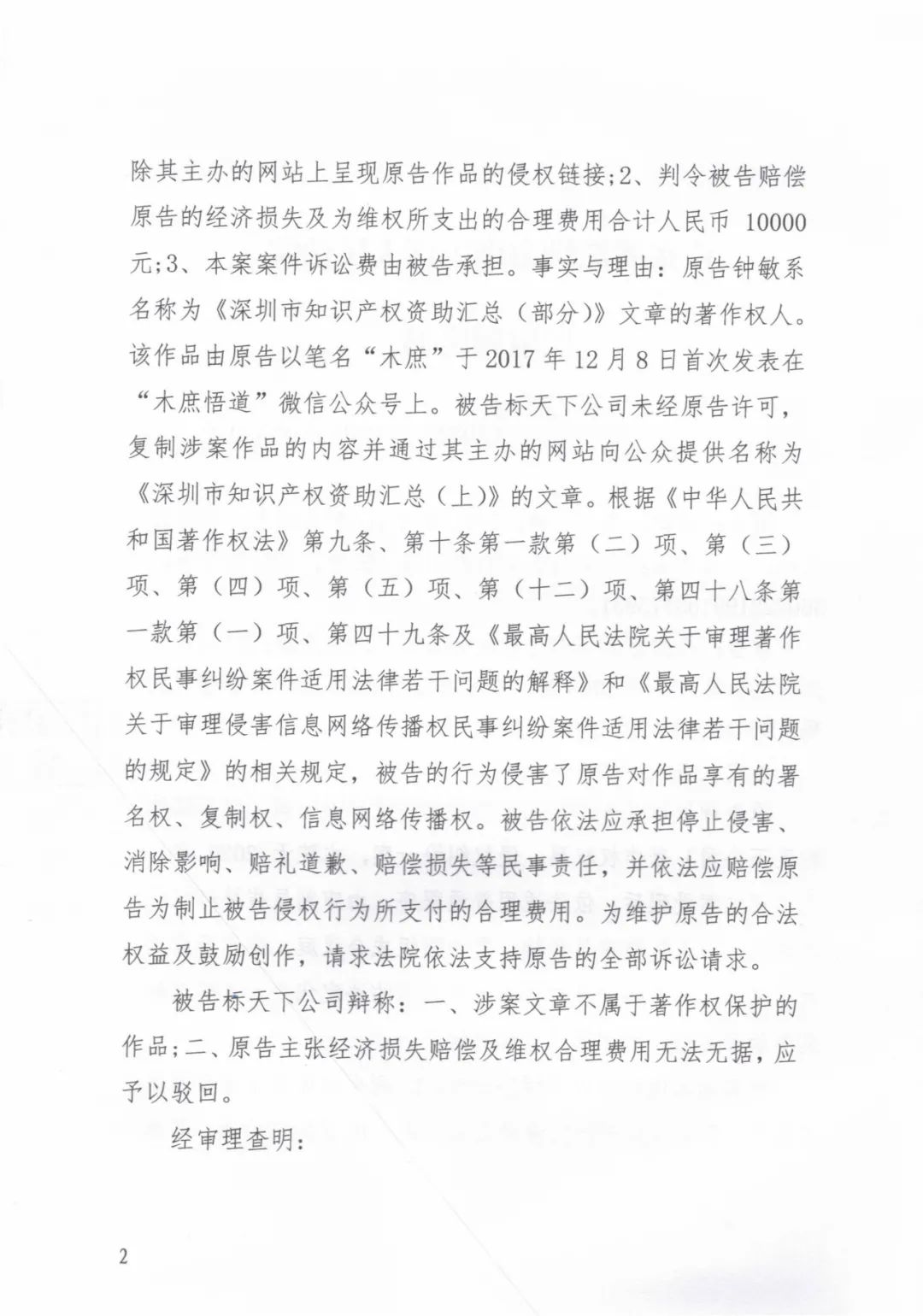

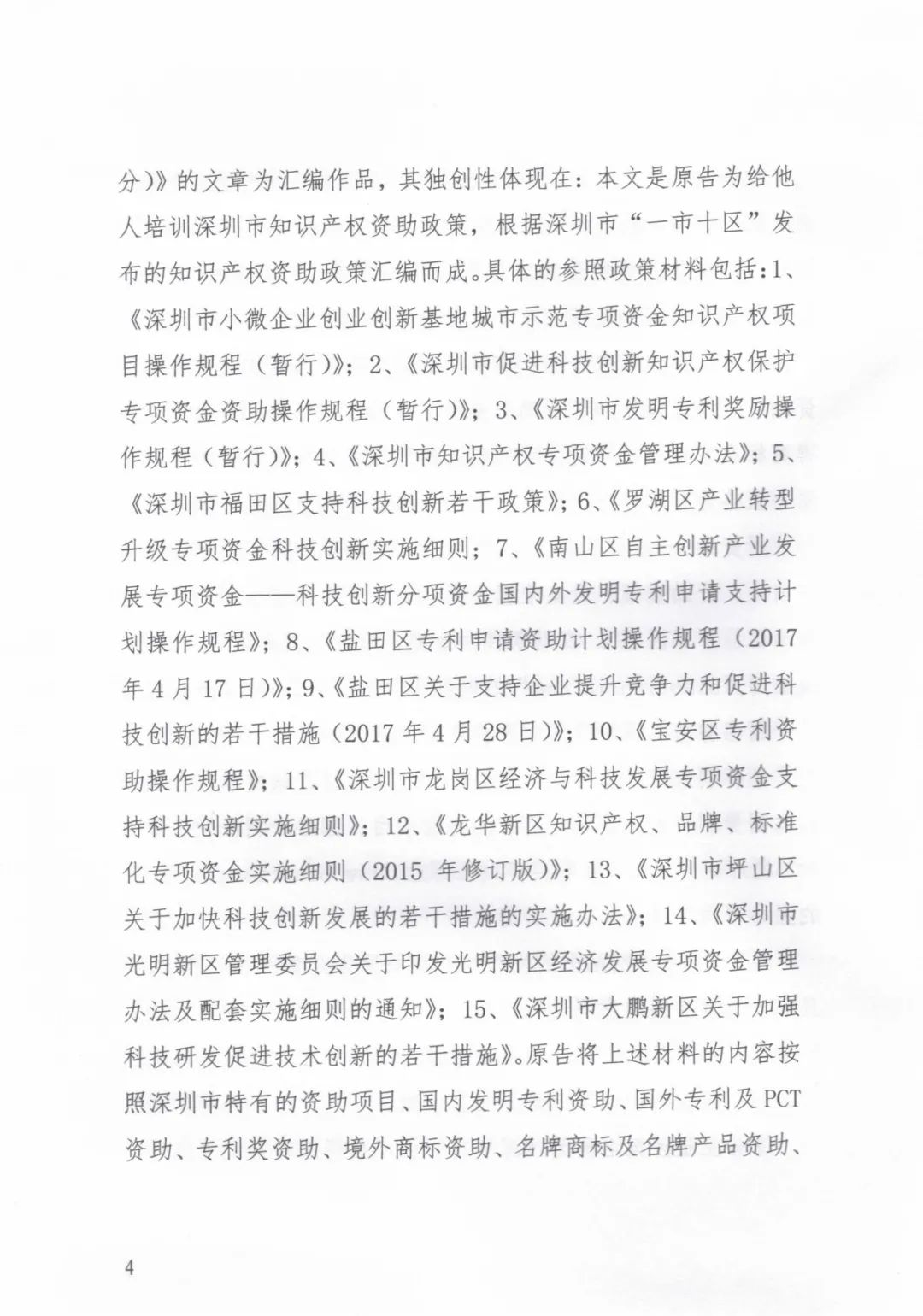
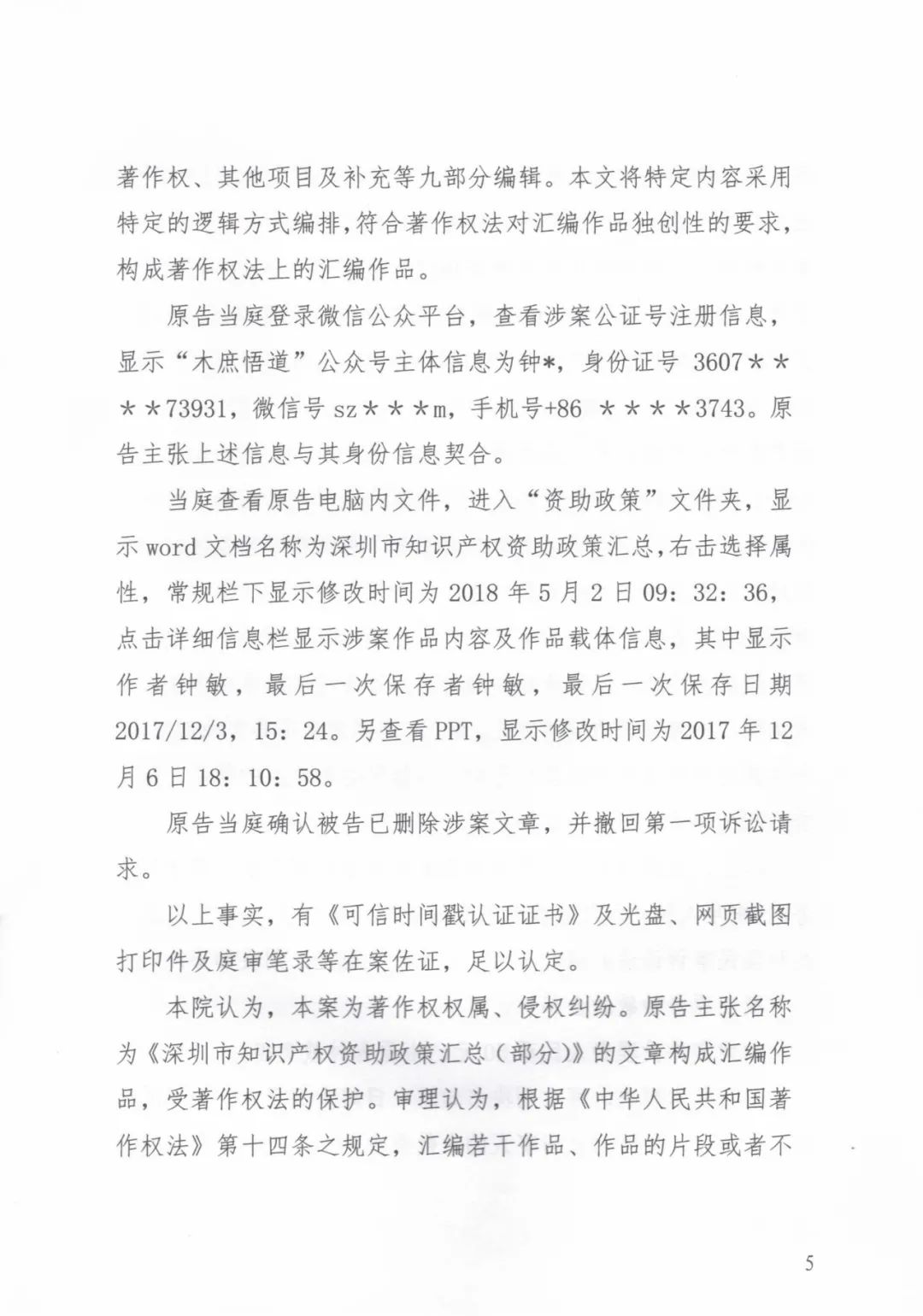
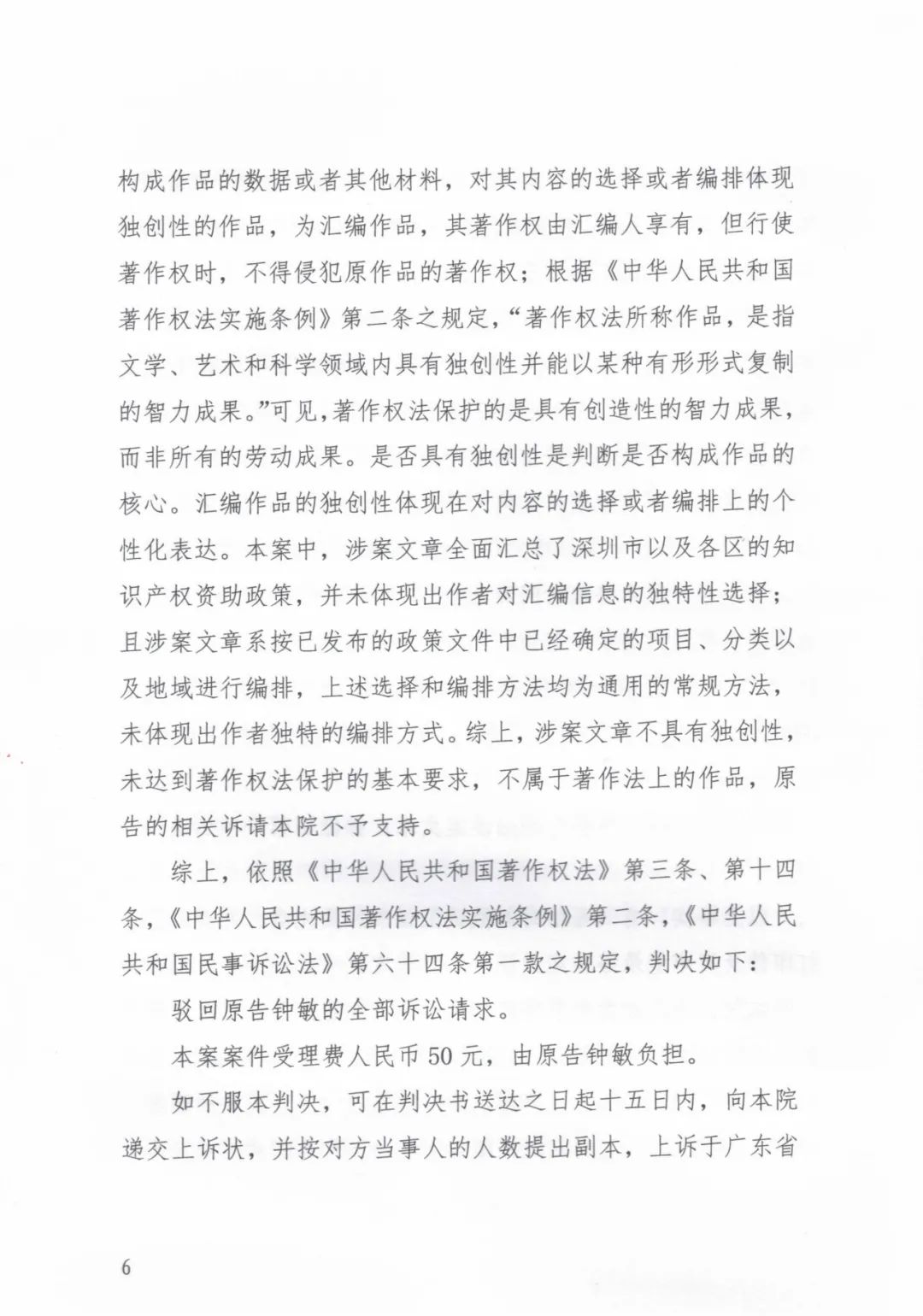
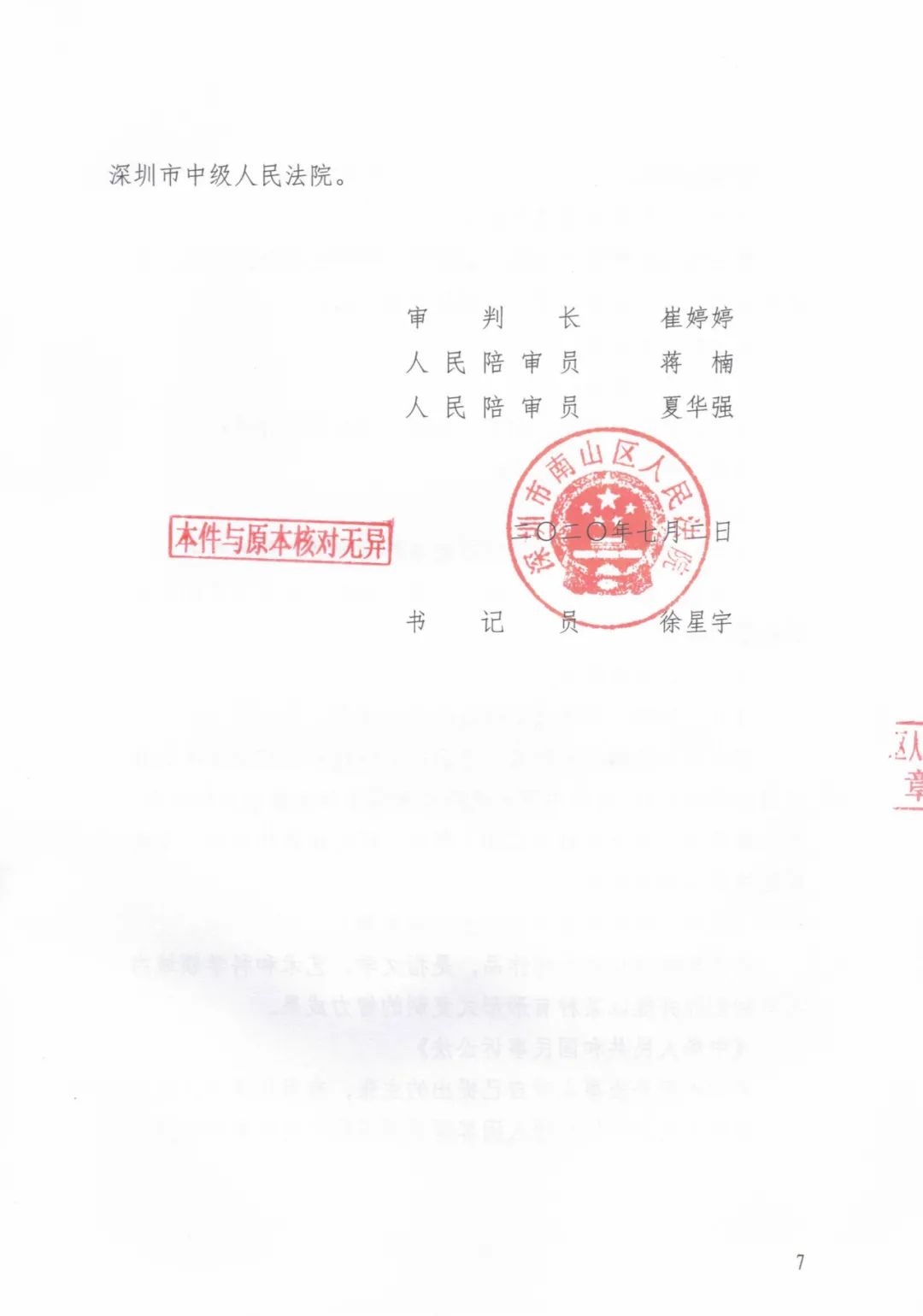
In response to the first instance judgment’s determination that the article in question lacks originality, I legally appealed to the Shenzhen Intermediate People’s Court, with the reasons for the appeal as follows:
The appellant believes that the facts established in the civil judgment No. (2020) Yue 0305 Min Chu 340 of the Nanshan District People’s Court of Shenzhen City (hereinafter referred to as the first instance judgment) are erroneous. Specifically, as follows:
The first instance judgment holds that “the article in question comprehensively summarizes the intellectual property funding policies of Shenzhen City and each district, and does not reflect the author’s unique selection of compiled information; furthermore, the article is arranged according to the projects, categories, and regions already determined in the published policy documents. The aforementioned selection and arrangement methods are common conventional methods and do not reflect the author’s unique arrangement method. Therefore, the article in question lacks originality and does not meet the basic requirements for protection under copyright law, and does not belong to works under copyright law,” which is a factual error.
1. The article in question meets the requirements for originality of compilation works under China’s Copyright Law and constitutes a compilation work under copyright law, and should be protected by the Copyright Law.
(1) Evaluation Criteria for Originality of Works
Originality of works should be evaluated from two levels: whether it belongs to the author’s independent creation and whether the work itself possesses a minimum level of creativity. At the level of independent creation, only the parts independently completed by the author can be included in the scope of originality evaluation. If a work contains both content created by others and parts independently created by the author, and the two are clearly separable, the author only has rights to the parts they created. At the minimum level of creativity, the evaluation is based on the expression of the work itself. That is, whether the expression of the work itself is distinguishable from similar prior works, and whether this distinguishable expression is obvious to ordinary technicians or workers in the relevant field. Only when the expression of the work itself is distinguishable from similar prior works and is not obvious to ordinary technicians or workers in the field does it meet the minimum creativity requirement.
(2) Evaluation Criteria for Originality of Compilation Works
The current Article 14 of China’s Copyright Law defines compilation works as those that compile several works, fragments of works, or data or other materials that do not constitute works, and where the selection or arrangement of their content reflects originality. Thus, it can be seen that the objects of compilation works include several works, fragments of works, or data or other materials that do not constitute works. Their originality can be reflected in both the selection of the content of the compiled objects and the arrangement of the selected content. Therefore, to determine whether a compilation work has originality, one should first examine the source of the content of the work, that is, the compiled object. After determining the compiled object, one should then examine the author’s selection criteria for the content of the compiled object. After determining the content selected based on the criteria, one should then examine the author’s arrangement method for the selected content. After determining these three elements, the above-mentioned criteria for evaluating the originality of works should be used to evaluate whether the specific compilation work has the originality stipulated by the Copyright Law.
(3) Specific Originality Expression of the Article in Question
1. The article in question was independently created by the appellant, meeting the requirements of independent creation in originality.
2. The compiled objects of the content of the article in question include the following 15 documents and data from the appellant’s work summary:
(1)Implementation Rules for the Intellectual Property Project of the Special Funds for the Demonstration of Urban Innovation and Entrepreneurship Bases for Small and Micro Enterprises in Shenzhen (Interim)
(2)Implementation Rules for the Special Funds for Promoting Technological Innovation and Intellectual Property Protection in Shenzhen (Interim)
(3)Implementation Rules for the Patent Award in Shenzhen (Interim)
(4)Management Measures for the Special Funds for Intellectual Property in Shenzhen
(5)Several Policies Supporting Technological Innovation in Futian District, Shenzhen
(6)Implementation Rules for the Special Funds for Industrial Transformation and Upgrading in Luohu District
(7)Special Funds for Independent Innovation Industry Development in Nanshan District—Implementation Rules for the Domestic and International Patent Application Support Program for Technological Innovation
(8)Implementation Rules for the Patent Application Funding Program in Yantian District(2017-04-17)
(9)Several Measures in Yantian District to Support Enterprises in Enhancing Competitiveness and Promoting Technological Innovation(2017-04-28)
(10)Implementation Rules for Patent Funding in Bao’an District
(11)Implementation Rules for the Special Funds for Economic and Technological Development in Longgang District to Support Technological Innovation
(12)Implementation Rules for the Special Funds for Intellectual Property, Brands, and Standardization in Longhua New District (2015 Revised Edition)
(13)Implementation Measures for Several Measures to Accelerate Technological Innovation Development in Pingshan District
(14)Notice of the Management Committee of Guangming New District on Printing the Management Measures for the Special Funds for Economic Development in Guangming New District and Supporting Implementation Rules
(15)Several Measures in Dapeng New District to Strengthen Technological Research and Development and Promote Technological Innovation
The appellant selected corresponding content based on their familiarity with intellectual property funding business from the compiled objects listed in item 2, categorizing them into patents, trademarks, copyrights, and other projects. Among them, patents include domestic invention patent funding, foreign patent authorization funding, PCT international application funding, and patent award funding. Patent awards include the National Patent Award, Guangdong Provincial Patent Award, and Shenzhen Patent Award. The National Patent Award includes the Patent Gold Award (Invention Patent Gold Award and Design Patent Gold Award); trademark funding includes funding for single national/region applications and funding for applications submitted through the Madrid system; other projects include high-tech enterprises, “Standardization” and other projects, with high-tech enterprises including national high-tech enterprises and Shenzhen high-tech enterprises. The corresponding content recorded in the documents is selected based on the funding amounts and applicant conditions for these projects.
4. After completing the work in item 3, the selected content was arranged.
First, the unique projects in Shenzhen among the other projects were arranged to form the section “Shenzhen Unique Projects.” This term “Shenzhen Unique Projects” did not exist prior and was first proposed by the appellant, intending to distinguish it from funding projects in other provinces or cities in Guangdong, rather than distinguishing it from projects in other provinces or cities across the country. The content of the projects in this section initially had no fixed logic, and even if others or the appellant rearranged them later, they might not necessarily be in this order. Because the projects in the section “Shenzhen Unique Projects” were arranged based on the appellant’s familiarity with the relevant funding policies at the time of writing this article and the appellant’s perception of the popularity of the relevant projects in Shenzhen, the projects considered most appealing to the audience were listed first.This fully expresses the appellant’s focus on developing intellectual property business for small and micro enterprises, especially trademark agency and patent insurance, which are of great concern to small and micro enterprises.Similarly, based on the same thought, the respondent focused on developing domestic invention patent agency business, so they placed the section on invention patent funding policies before the “Shenzhen Unique Funding Policies.”As for the following items after “Shenzhen Unique Projects,” because they mainly target large companies, the appellant had transitioned from a senior intellectual property consultant at an agency to an intern lawyer at a law firm, and these were no longer the appellant’s target clients, so they were placed later. Therefore, the arrangement of the projects in the “Shenzhen Unique Funding Projects” section reflects the appellant’s unique thoughts and is a specific expression of the appellant’s shift in business focus, and this expression is unusual, meeting the requirements for originality under the Copyright Law.
Next, after completing the arrangement of “Shenzhen Unique Funding Policies,” the appellant arranged the relevant projects related to patents, forming “Domestic Invention Patent Funding,” “Foreign Patents, PCT Funding,” and “Patent Award Funding.” The funding units in each section were arranged starting from Shenzhen City, followed by Futian District, then Luohu District, and then Nanshan District, followed by Yantian District, Bao’an District, Longgang District, Longhua District, and finally Pingshan District, Guangming New District, and Dapeng New District. This sorting method reflects the distribution of the appellant’s business focus. After years of experience as an intellectual property consultant, the appellant has achieved a concentration of business “within the customs,” meaning that business is mainly concentrated in Shenzhen City. Placing Futian District first is because the law firm where the appellant interned was located in Futian, and the target client group of the intern lawyer team was enterprises in Futian. The second position was given to Luohu instead of Nanshan because the appellant’s foundation as an intellectual property consultant was in Luohu, with major clients distributed in Shuibei, Tianbei, and Liantang, and the intellectual property funding policies in Luohu at that time were quite attractive, aiming to develop business in Luohu District. Although Nanshan District has many high-tech enterprises, the appellant had less business there, and competition was fierce, so it could only rank third in the appellant’s arrangement. This sorting method is relatively unusual among relevant personnel in the field. As for Yantian District being placed before Bao’an, Longgang, and Longhua, it was mainly because the appellant’s lawyer team had many lawyers from BGI and wanted to develop business in Yantian District, hence this treatment. Bao’an, Longgang, and Longhua were the appellant’s business concentration areas before entering the customs, and thus were placed right after Yantian. Pingshan District, Guangming New District, and Dapeng New District were included only for the sake of completeness of information.Therefore, the sorting of funding units in “Domestic Invention Patent Funding,” “Foreign Patents, PCT Funding,” and “Patent Award Funding” expresses the regional distribution of the appellant’s business within Shenzhen and the intended development of regional distribution. This expression should be different from ordinary people.
Additionally, in the “Foreign Patents, PCT Funding” section, the “Foreign Patent” authorization funding and “PCT International Stage” funding, which should have been divided into two sections, were merged into one section. The appellant knew that this arrangement would make this section cluttered, but based on the appellant’s relevant business experience and business philosophy, they chose to do the opposite and arranged them together.The intention was to indicate that “the article is written for those who understand” and “to do professional business for professionals.”Because only professionals in the field would understand the specific meanings and processes of terms like “obtaining international search” and “national phase” without prior explanations.
As for why the “Patent Award Funding” section only lists the National Patent Gold Award and National Patent Excellence Award and Shenzhen Patent Award but does not include the Guangdong Provincial Patent Award? It is evident to ordinary workers in the field that the Guangdong Provincial Patent Award should be included for comprehensiveness. However, the appellant intentionally did not include the Guangdong Provincial Patent Award because they did not know how and when to report it, and to reduce the corresponding trouble, they chose not to include it.This arrangement expresses the appellant’s business philosophy of “not wanting to earn all the money.”
Furthermore, the “Overseas Trademark Funding” section arranged the funding policies of Shenzhen City, Bao’an District, and Longhua District for Madrid, single national, and the special administrative regions of Hong Kong, Macau, and Taiwan. Although, due to special historical reasons, trademarks in Hong Kong, Macau, and Taiwan can only be applied for through a single registration method, in this article in question, the appellant separated Hong Kong, Macau, and Taiwan from other single countries or regions but arranged these three regions in the same column, that is, a “separate yet centralized” arrangement. On one hand, this is a random choice of arrangement technique; on the other hand, it could have been arranged separately. However, the appellant chose to distinguish “Hong Kong, Macau, and Taiwan” from other single countries or regions while centralizing them in the arrangement. This was based on the following considerations:
(1) Although due to special reasons, trademarks in “Hong Kong, Macau, and Taiwan” must be applied for in a single manner, “Hong Kong, Macau, and Taiwan” are inherent parts of our territory and must be distinguished from other countries and regions in this regard.
(2) Not separating “Hong Kong, Macau, and Taiwan” is because “separating” sounds like “splitting,” which could imply a crime of splitting the country, posing too great a risk.
Thus, the special arrangement of the content in the “Overseas Trademark Funding” section expresses the appellant’s deep patriotism.
Finally, the infringing article did not replicate parts of the article in question, so I will not comment on its originality here.
(4) Conclusion
Articles are written for the times, and articles are written for the matter. When the appellant created the article in question, they were facing a critical period of career transition, and the intent of creating the article was to develop relevant business. The arrangement order between the sections of the article in question, the arrangement order of the relevant projects within each section, the arrangement order of the funding units within each section, and the meticulous handling of special sections fully express the appellant’s target groups for business development, key business areas, regional distribution of target clients, business philosophy, and maintenance of national unity and territorial integrity.
2. The article in question does not belong to common conventional expressions, nor does it belong to specific unique expressions.
The first instance court believed that the content selection and arrangement methods of the article in question were all common conventional methods, which reflects the first instance court’s subjective and hasty interpretation of the article in question. The first instance court neither searched for relevant articles in the field nor fully understood the connotation of the article in question based on the specific circumstances at the time of its creation, but rather came to the conclusion that “the content selection and arrangement methods of the article in question were all common conventional methods” based solely on subjective conjecture at the time of trial, which seems to have the air of “hindsight.”
In fact, by searching for keywords such as “Shenzhen City,” “2017,” “intellectual property funding policies” on any search engine, the prior relevant documents retrieved are significantly different in content selection and arrangement methods from the content of the article in question. Therefore, the article in question neither belongs to common conventional expressions nor to specific, unique expressions of relevant articles in the field.
In summary, the article in question meets the minimum requirements for originality of compilation works under copyright law, does not belong to common conventional expressions, nor does it belong to specific unique expressions, constitutes a compilation work under copyright law, and should be protected by copyright law.
After written deliberation, the second instance court made the following judgment:
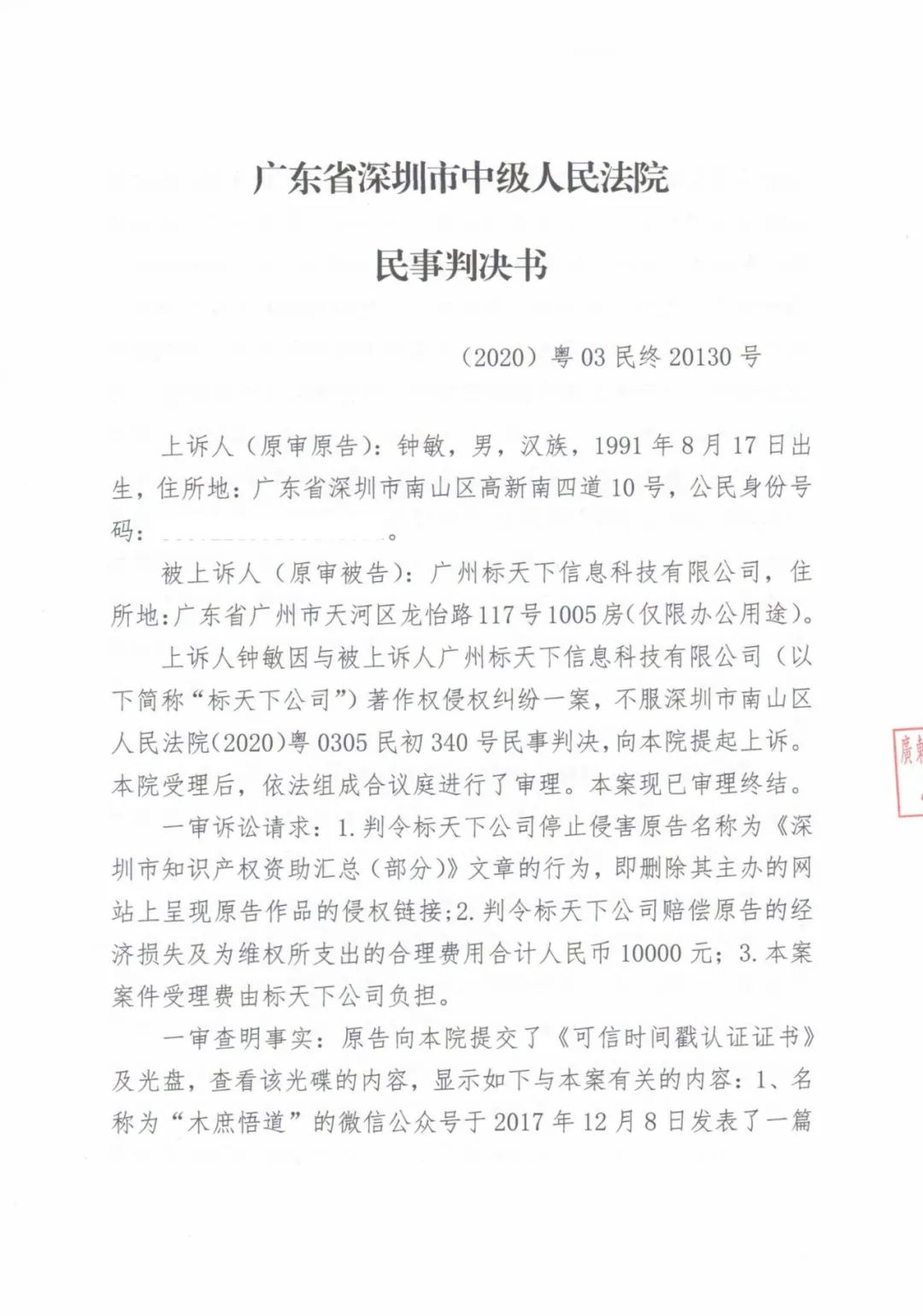
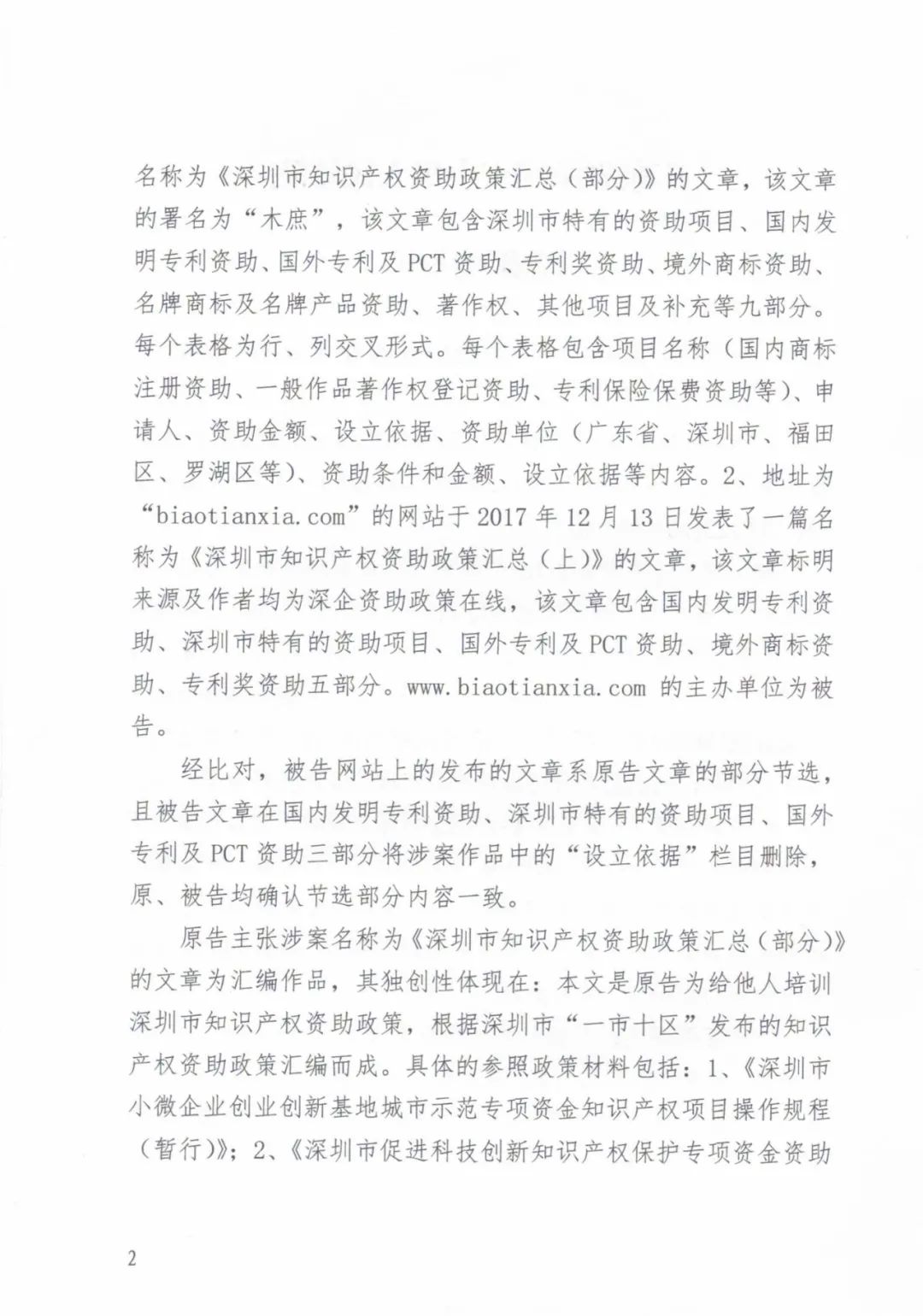



Because the second instance judgment did not reflect my reasons for appeal, further exploration is still needed regarding how to specifically assess the originality of compilation works.